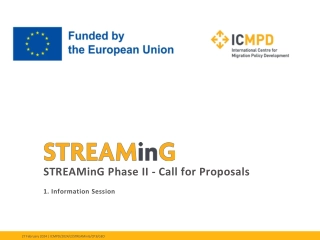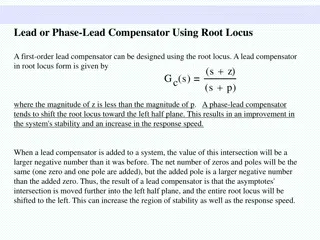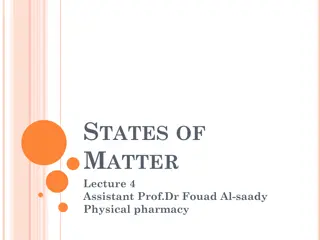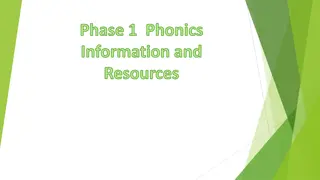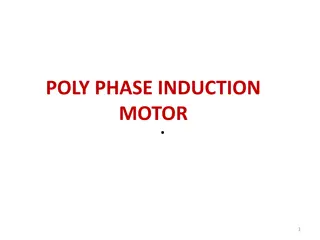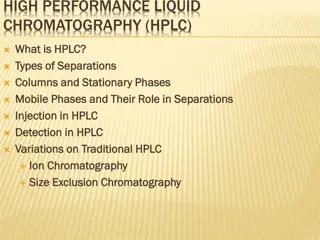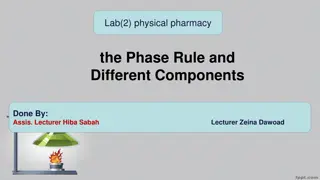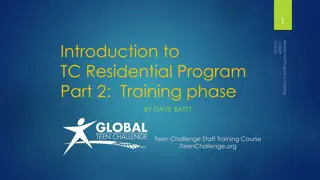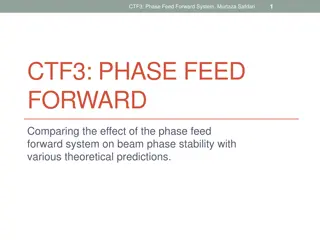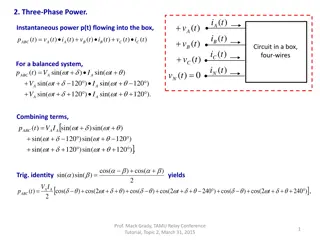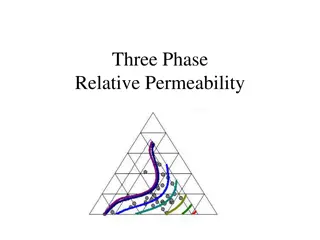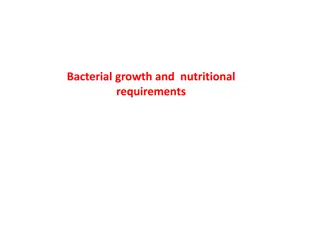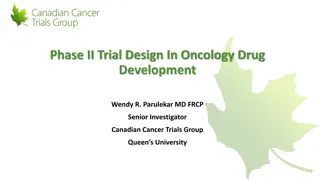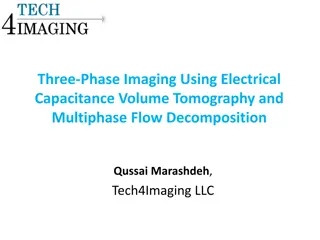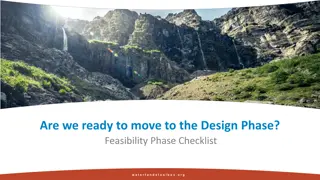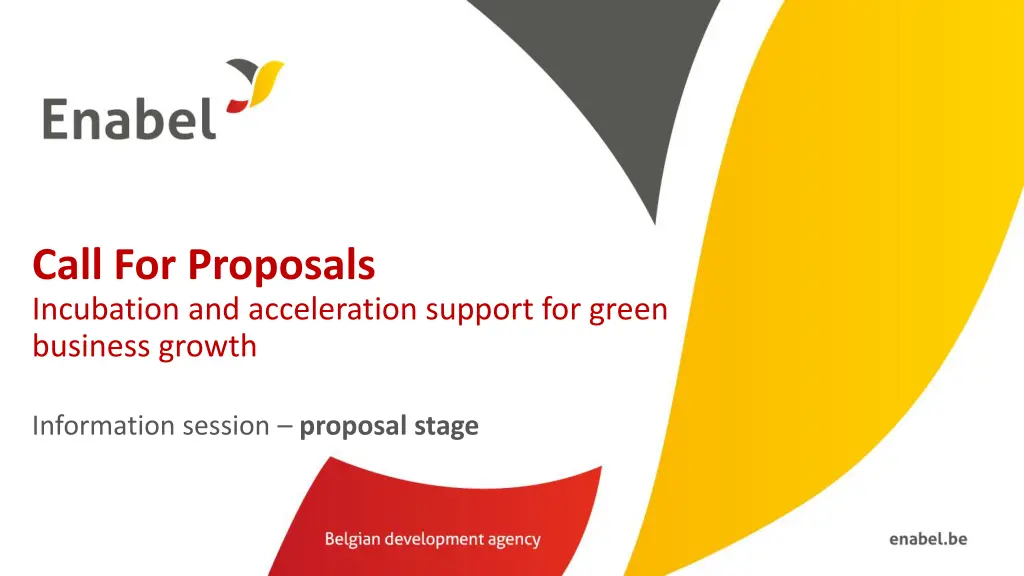
Green Business Incubation and Acceleration Support Program
Join our initiative to support green businesses in Uganda through incubation and acceleration programs. Unlock growth potential for innovative start-ups and scale-ups in the Green and Circular Economy, creating new decent jobs.
Download Presentation

Please find below an Image/Link to download the presentation.
The content on the website is provided AS IS for your information and personal use only. It may not be sold, licensed, or shared on other websites without obtaining consent from the author. If you encounter any issues during the download, it is possible that the publisher has removed the file from their server.
You are allowed to download the files provided on this website for personal or commercial use, subject to the condition that they are used lawfully. All files are the property of their respective owners.
The content on the website is provided AS IS for your information and personal use only. It may not be sold, licensed, or shared on other websites without obtaining consent from the author.
E N D
Presentation Transcript
Call For Proposals Incubation and acceleration support for green business growth Information session proposal stage
Presentation Presentation outline outline 1. Introduction & objectives - RECAP of the CfP 2. Concept note selection process summary 3. Proposal template a) Annex A; part B, proposal b) M&E logical framework, Indicators c) Discussion on budgeting (Budget template) 4. Application procedure/next steps
1. Introduction & objectives - RECAP of the CfPs Call Objectives Call Objectives General objective Enhanced contribution to the Ugandan private sector in realising sustainable development for green growth and decent jobs Specific objective Unlocked growth potential of at least 70 innovative start-ups and scale-ups in the Green and Circular Economy (CGE) through incubation and acceleration support and resulting in the creation of at least 250 new, decent jobs
1. Introduction & objectives - RECAP of the CfPs Call objectives Call objectives - - outputs outputs 1. At least 50 early-stage businesses in the CGE are supported to successfully launch their business in the market and realise growth through incubation (lot 1) 2. At least 20 scale-ups in the GCE are supported to scale their business models through acceleration (lot 2)
1. Introduction & objectives - RECAP of the CfPs Call Objectives Call Objectives KPI for business KPI for business growth growth - Lot 1: At least 20% revenue growth at the end of the action for enterprises participating in incubation programmes; and on average 3 new, direct or indirect decent jobs created per enterprise at the end of the action; - Lot 2: At least 50% revenue growth at the end of the action for businesses participating in acceleration programmes; and on average 5 new, direct or indirect decent jobs created per enterprise at the end of the action.
2. Concept note selection process summary CN (stage 1) selection process 41 concepts were received (26 lot 1, 15 lot 2) 30 applications failed at admissibility (20 lot 1, 10 lot 2), while 11 proceeded to technical evaluation (6 lot 1, 5 lot 2) 6 shortlisted concept notes invited for 2ndstage (3 each lot, absorbing 300% of total call volume per lot) Deadline submission proposals = Monday May 26, 5PM
2. Concept note selection process summary Evaluation - Concept note vs Proposals Focus CN RELEVANCE of proposed action Focus Proposals RELEVANCE of proposed methodology/strategic approaches EFFECTIVENESS & FEASIBILITY CAPACITY/EXPERIENCE
2. Concept note selection process summary Content - Concept note vs Proposals No substantial changes to the initial CN Requested contribution cannot vary more than 20% from initial estimate + must remain between the min and max that can be requested lot 1: 150,000 300,000 EUR ; 15 24 months* lot 2: 450,000 900,000 EUR ; 15 33 months*
3. Proposal template a) Annex A; part B proposal a) Annex A; part B proposal Detailed description of the action & methodology 6 sections (description, strategic approach, methodology (who/what/when/how), action plan, risks & assumption, sustainability) log frame budget Administrative data and information for lead and co-applicant(s) The lead applicant s experience for similar and other actions Capacity to manage and perform actions (experience in the sectors) Resources (financial data, source of financing, number of people employed) The co-applicant(s) experience for similar and other actions History of cooperation with lead applicant Capacity to manage and implement actions (experience in the sectors) The associates (if any) - participate actively in the action, but are not eligible for grants and only qualify to receive daily allowances and travelling expenses) Mandate for each co-applicant and associates signed Declaration for lead applicant signed *any sub-grants must be indicated under methodology
RECAP of the CfPs Target groups RECAP Target groups RECAP Young, innovative and dynamic enterprises in the Green and Circular Economy (CGE), i.e. with potential to grow/scale, and, as such, contribute to job creation. Lot 1 Incubation: - Have basic proof of concept (PoC) and initiated market testing/exploration; - Aligned with and show the potential for innovation in the GCE - Market-driven and demonstrating potential for scalability (even if they have not yet proven market viability) - Have a product prototype and/or are undergoing product testing or research and development and are looking to launch in the market.
RECAP of the CfPs Target groups RECAP Target groups RECAP Young, innovative and dynamic enterprises in the Green and Circular Economy (CGE), i.e. with potential to grow/scale, and, as such, contribute to job creation. Lot 2 Acceleration: - Have a market-ready solution and are looking to scale their solution; Validated MVP - Aligned with and show the potential for innovation in the GCE - Demonstrate market traction, such as revenue, customer acquisition, strategic - Partnerships, financial sustainability and showing readiness for scaling regionally or globally; - Demonstrate growth realized, in terms of number of staff and a minimum annual turnover of 20,000 EUR; - Motivated and committed teams
! Attention points ! Detail/elaborate approaches/methodology of different elements of the action (what, who, how, how long etc) Clarifying approaches to develop/scale market driven solutions and innovations Approaches to clearly demonstrate relevance of technical assistance to the specific needs of the target group (incubation vs acceleration support needs, needs for scaling innovations, addressing barriers specific to GCE start-ups, customized access to finance strategies etc) Holistic approaches to market access (market entry, entry in new markets, sales partnerships etc) Lot 1: attention for market/customer validation
! Attention points ! Attention for strategies to promote decent job creation and inclusion Clarify clearly the role of (and/or engagement with) each stakeholder in implementation: applicant, any co-applicant(s), any sub-grantee, any associate External stakeholders: community, local govt, private sector Ensure Logical flow between activities & structuring between different phases (eg. Inception, baseline, implementation, end-line) Ensure 100% alignment of structure between narrative, activity plan, budget & logframe
3b. Sub-grants to sub-recipients (optional) Restricted to specific categories (other categories inadmissible) Lot 1 Incubation : Seed grants Lot 2 Acceleration : matching grants or loan-matching grants Restricted to conditions per category
3b. Sub-grants to sub-recipients Applicants selected to go to 2nd/proposal stage need to elaborate: 1. The description of the objectives and results to be achieved with these sub- grants, the fundamental principles, the key concepts, the mechanisms, the actors and their role in the management process; 2. The criteria and modalities for the allocation of grants, accessibility conditions sub-beneficiaries, conditions for the admissibility of sub-projects, eligibility conditions for activities, costs and expenses; 3. The procedures for examining and awarding applications; 4. The maximum amount that can be allocated by sub-beneficiary; 5. The terms of contractualization with the sub-beneficiary; 6. The procedures and modalities for disbursing resources; 7. The procedures and modalities for technical and financial monitoring; 8. The procedures and modalities of control. Make sure to clarify clearly all 8 points!
3b. Conditions sub-grants lot 1 = Seed grants Maximum 30% of the total budget of the action Max EUR 5000 per selected enterprise; Any seed grants must be non-refundable; Supported enterprises must have successfully completed the incubation programme organized under the action and developed/refined the necessary documents as defined and guided by the applicant (eg. business plans, investments proposals, financial projections, ...); Approval of seed grants for supported businesses will be done by a selection committee which is to include representatives of Enabel, and by applying key selection/awarding criteria (competitive)
3b. Conditions sub-grants lot 1 = Seed grants Eligible costs for seed grants: Business set-up costs (equipment, raw materials, working capital etc) Marketing, market research and market testing activities; Technology adoption; Product research and development activities; Compliance with legal and regularity requirements (costs for legal services to secure licenses, product or service copy rights, product certifications, licenses and permits to operate legally); Fundraising costs such as travel costs to investor events in preparation for investment readiness; Other activities that are be linked to the launch and growth of an enterprise. Non-business-related costs (e.g. personal expenses or assets) and repayment of existing debts or loans cannot be eligible for seed funding.
3b. Conditions sub-grants lot 2 - Acceleration Matching grants to enterprises supported under the action Eligible enterprises must contribute a minimum of 50% of the required investment (1:1 ratio); AND/OR Loan-matching grants to financiers providing credit to the enterprises supported under the action to repay a % of the loan new and regulated loan/investment during participation in the acceleration for investments linked to growth strategy. Loan-matching grants cannot exceed 30% of the loan amount raised by an enterprise (and cannot exceed EUR 30,000). To be paid to the financier (as a formalized re-imbursement on the borrower account).
3b. Conditions sub-grants lot 2 - Acceleration Maximum 40% of the total budget of the action Max EUR 30,000 per selected enterprise; Any matching grants or loan-matching grants must be non-refundable; Approval of (loan-)matching grants for supported businesses will be done by a selection committee which is to include representatives of Enabel, and by applying key selection/awarding criteria
3b. Conditions sub-grants lot 2 - Acceleration Eligible costs for (loan-)matching grants: Market expansion and acquisition activities; eg. market research, marketing, branding and advertising activities or materials; Product or service development and diversification; eg product research and development to enhance quality and/or diversify to enhance market access; Technology adoption; Implementation of sustainability initiatives; Investment in working capital; Acquisition of the essential equipment; Activities/costs aimed at obtaining certification to be able to access regional and global markets; Other Initiatives that are linked to the growth of an enterprise.
3. Proposal template a) Annex A; part B proposal
3. Proposal template b) M&E, framework, indicators b) M&E logical framework, indicators Use Annex C: logframe template and explain logic
3. Proposal template b) M&E, framework, indicators Logical flow Planned work Intended results Assumptions Assumptions& & risks risks Resources/ Resources/inputs inputs Activities Activities Outputs Outputs Outcome Outcome Impact Impact Number trained, sensitized Products developed and shared Equipment distributed Short term Knowledge/skills acquired Attitudes changed Change in behaviour Decisions made Actions undertaken Long term Social change Economic change Environmental change ... Problem analysis Stakeholder analysis Objectives Risk analysis Staff Time Money Materials Equipment Technology ... Workshops Meetings Field trips Trainings Service delivery ... Participant is object Participant is subject
3. Proposal template b) M&E, framework, indicators
3. Proposal template b) M&E, framework, indicators
3. Proposal template b) M&E, framework, indicators Example Impact/GO IMPACT - Enhanced contribution to the Ugandan private sector in realising sustainable development for green growth and decent jobs X% of project participants have increased turnover of at least 20%/50% by the end of the action X% of project participants have created X number of new, decent jobs X% of project participants have improved staff working conditions in at least one or more key dimensions of decent work X% of project participants have raised capital by the end of the action
3. Proposal template b) M&E, framework, indicators Example Outcome/SO OUTCOME X innovative incubation/acceleration support X% of project participants have a validated MVP by the end of the action/ X% of project participants that have successfully launched a new green/circular product service (lot 1) % of enterprises demonstrating improved financial management practices, as measured by business diagnostics or follow-up assessments X% of project participants reporting increased customer base or market reach - Unlocked start-ups/scale-ups growth potential in the of at least GCE through
3. Proposal template b) M&E, framework, indicators Example Output/results X # of start-ups/scale-ups supported to XXX = service delivery
3. Proposal template b) M&E, framework, indicators
c) Proposal template - Budget The budget need to be coherent with the activities in the narrative & action plan NUMBERING: Activity 1 in the narrative planning need to be transferred to a budget line for activity 1 TIMING: if you plan activity 1 in quarter 1 only, then you will only foresee a budget in quarter 1 for that activity CODING: Codes correspond with the Logframe: Specific Objective, 01 Result number one,01 Activity Number one under result no One.A0101.3rd level relates to sub activities e.g A010101,A010102
c) Proposal template - Budget On a daily basis you will work with UGX, but the official max grant amount is in euro which you cannot exceed, so follow up of execution in euro is needed. FX rate of UGX 4000: 1 EUR (grantees can use their own exchange rate (based on a reliable source) to estimate the budget). Exchange rate losses are ineligible costs and should be covered by the grantees themselves (e.g. through structure costs). Additionally, since the purpose of the grant is not to make money, any gains (exchange or interest) made on the funds received from Enabel must be re-used for the activities after Enabel approval.
c) Proposal template - Budget The budget is broken down in 3 cost components; 1. Operational costs (actual activity costs - general means cost): necessary and indispensable cost for achieving the objectives and results of the action, including the cost for achieving verifiable deliverables Ex : fees for instructors, consultancy fees, fuel for transporting, workshop costs, training materials, food for trainees, fees for trainees etc. 2. Management costs (costs to support the management team): identified costs related to management, supervision, coordination, monitoring, control, evaluation and financial audit which specifically originate in the implementation of the action or the justification of the Grant Ex : Salary for staff, Mid-term evaluation, special audit costs 3. Structure costs (7% max of eligible operational costs) costs related to the achievement of the social purpose of the beneficiary, which cannot be separated or charged to the budget of this action even though they are affected by the implementation of the action. They are a max of 7% of the eligible operational costs. Ex: supporting staff (those that cannot be justified under management costs through timesheets e.g., procurement), water & electricity & internet of the office etc.
c) Proposal template - Budget What are the rules concerning structure costs? - The percentage (max.7%) must be justified before signature of the Grant Agreement and correspond to the general structure costs of the grantee - It s a lump-sum and maximum 7% of operational costs - Once the % has been set and confirmed by the analysis of the grantee s accounts, no supporting document have to be provided by the grantee. In the reporting, it just appears as a separate line at the end (+ 7%).
c) Proposal template - Budget Ineligible costs (1/2): Expenses that are included in the ineligible list (see guidelines) Expenses that are incurred before or after the duration of this grant agreement Expenses that cannot be identified, verified and are not included in the grantee's accounts Expenses not in line with applicable legal fiscal and social provisions Expenses that are not reasonable, justified, not respecting the principle of good financial management, in particular concerning cost efficiency and effectiveness Expenses not in line with the action plan, not necessary to achieve the results No contributions in kind are considered
c) Proposal template - Budget Ineligible costs (2/2): Accounting entries not leading to payments Provisions for liabilities and charges, losses, debts or possible future debts Debts and debit interests Doubtful debts Currency exchange losses Loans to third parties Guarantees and securities; Costs already financed by another grant Invoices made out by other organisations for goods and services already subsidized Subcontracting by means of service or consultancy contracts to personnel members, Board members or General Assembly members of the organization subsidized Any sub-letting to oneself Purchases of land or buildings; Compensation for damage falling under the civil liability of the organization Employment termination compensation for the term of notice not performed Purchase of alcoholic beverages, tobacco and derived products thereof
c) Proposal template - Budget Indicative Costs
4. Application procedure / Next steps 4. Application procedure / Next steps Use the complete Annex A Grant Application File, Part B. Do not use own templates & do not tweak the template Submission in English only Provide a detailed budget (annex B)- Amount requested in the proposal may not vary more than 20% in relation to the initial estimate Errors or major inconsistencies concerning the points mentioned in the instructions of the form may result in rejection (e.g., content required, pages, ) Enabel reserves the right to request clarification where the information provided does not enable it to carry out an objective evaluation
4. Application procedure / Next steps Submission Submission proposal proposal Deadline for application: 26/05/2025 at 5 PM EAT !!! Online submission form Submit : https://submit.link/3Fw SUBMISSIONS BY EMAIL/POST AUTOMATIC REJECTION
4. Application procedure / Next steps Application Application procedure procedure REMAINING QUESTIONS: uga_csc_grants@enabel.be Subject: reference number- UGA22003 -10040 Questions can be submitted until 5thMay Answers will be published on https://www.enabel.be/grants/ latest by 15thMay
4. Application procedure / Next steps Application Application procedure procedure ! Primary source of information Guidelines, annexes, clarifications (Q&A) and all other communication & updates: https://www.enabel.be/grants/ SELECT UGANDA OPEN CALLS - FILTER REFERENCE NUMBER UGA22003 -10040
4. Application procedure / Next steps Submission Submission proposal proposal Online submission form Submit : https://submit.link/3Fw - Avoid last minute submission; System automatically closes when past deadline - Start working on a draft timely (you can always go back to your draft, it saves automatically) - Get documentation (annexes to the application file) ready on time; you cannot proceed to uploading application file before uploading the annexes)
4. Application procedure / Next steps NEXT STEPS NEXT STEPS Invitations to submit the proposals April 24th, 2025* NA May 5th, 2025 5:00 pm Deadline for clarification requests to the contracting authority May 15th, 2025* 5:00 pm Response to clarification requests are given by the contracting authority May 26th2025 Deadline for the submission of the proposals 5:00 pm Opening, administrative checks and evaluation of proposals May 27th June 13th, 2025* NA Request certificates and supporting documents relating to the grounds for exclusion (see 2.1.1 (2)) June 18th, 2025* 5:00 pm June 18th June 25th, 2025* Onsite organizational analysis of the successful applicants after technical evaluation NA Receipt of certificates and supporting documents relating to the grounds for exclusion July 2nd, 2025* 5:00 pm Notification of the award decision and transmission of signed grant agreement July 9th, 2025* NA Signature of the Agreement by contracting beneficiary July 11th, 2025* NA

